NCERT Solution Ch-9 Algebraic Expressions and Identities
Chapter 9, “Algebraic Expressions and Identities,” from the NCERT Class 8 Maths curriculum, along with some common types of problems and their solutions.
1. Algebraic Expressions: An algebraic expression is a combination of numbers, variables, and operators (like +, −, ×, ÷).
2. Terms, Coefficients, and Constants:
- Terms are the parts of an expression separated by + or − signs.
- Coefficients are the numerical factors of the terms.
- Constants are fixed values without variables.
3. Types of Algebraic Expressions:
- Monomial: An expression with one term (e.g., 5x5x5x).
- Binomial: An expression with two terms (e.g., 3x+43x + 43x+4).
- Trinomial: An expression with three terms (e.g., 2×2+3x+52x^2 + 3x + 52x2+3x+5).
Polynomials: A polynomial is an algebraic expression consisting of terms with non-negative integer exponents.
Identities: Algebraic identities are equations that hold true for all values of the variables involved.
NCERT Solutions of Class 8th Chapter 9 Algebraic Expressions and Identities Exercise 9.1, 9.2, 9.3, 9.4, 9.5
We try to teach you all Questions in easy way. We solve all chapter wise sums of maths textbook. In every chapter include NCERT solutions. For solutions of Exercise9.1, 9.2, 9.3, 9.4, 9.5 click on Tabs :
Question 1.
Identify the terms, their coefficients for each of the following expressions.
(i) 5xyz2 – 3zy
(ii) 1 + x + x2
(iii) 4x2y2 – 4x2y2z2 + z2
(iv) 3 – pq + qr – rp
(v) x/2+ y/2 – xy
(vi) 0.3a – 0.6ab + 0.5b
Solution:
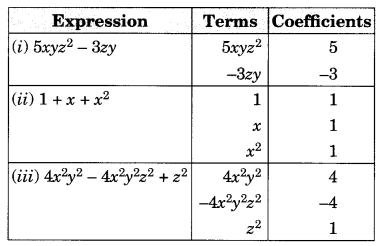
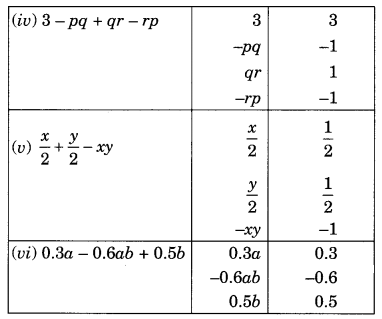
Question 2.
Classify the following polynomials as monomials, binomials, trinomials. Which polynomials do not fit in any of these three categories?
x + y, 1000, x + x2 + x3 + x4, 7 + y + 5x, 2y – 3y2, 2y – 3y2 + 4y3, 5x – 4y + 3xy, 4z – 15z2, ab + bc + cd + da, pqr, p2q + pq2, 2p + 2q
Solution:
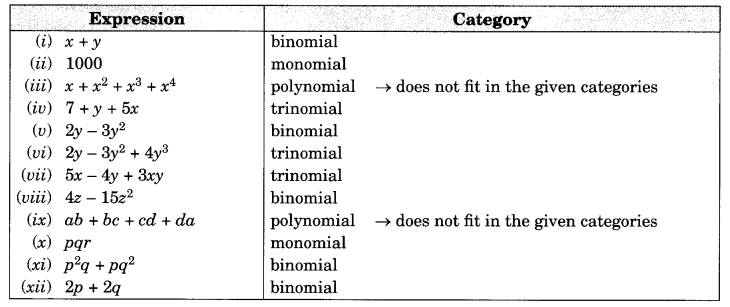
Question 3.
Add the following:
(i) ab – bc, bc – ca, ca – ab
(ii) a – b + ab, b – c + bc, c – a + ac
(iii) 2p2q2 – 3pq + 4, 5 + 7pq – 3p2q2
(iv) l2 + m2, m2 + n2, n2 + l2, 2lm + 2mn + 2nl
Solution:
(i) Given: ab – bc, bc – ca, ca – ab
We have
(ab – bc) + (bc – ca) + (ca – ab) (Adding all the terms)
= ab – bc + bc – ca + ca – ab
= (ab – ab) + (bc – bc) + (ca – ca) (Collecting the like terms together)
= 0 + 0 + 0
= 0
(ii) Given:
a – b + ab, b – c + bc, c – a + ac
We have (a – b + ab) + (b – c + bc) + (c – a + ac) (Adding all the terms)
= a – b + ab + b – c + bc + c – a + ac
= (a – a) + (b – b) + (c – c) + ab + bc + ac (Collecting all the like terms together)
= 0 + 0 + 0 + ab + bc + ac
= ab + bc + ac
(iii) Given:
2p2q2 – 3pq + 4, 5 + 7pq – 3p2q2
By arranging the like terms in the same column, we have
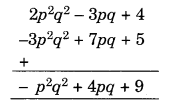
(iv) Given: l2 + m2, m2 + n2, n2 + l2, 2lm + 2mn + nl
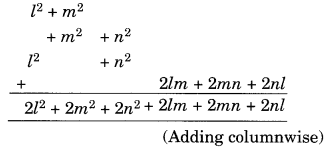
Thus, the sum of the given expressions is 2(l2 + m2 + n2 + lm + mn + nl)
Question 4.
(a) Subtract 4a – 7ab + 3b + 12 from 12a – 9ab + 5b – 3
(b) Subtract 3xy + 5yz – 7zx from 5xy – 2yz – 2zx + 10xyz
(c) Subtract 4p2q – 3pq + 5pq2 – 8p + 7q – 10 from 18 – 3p – 11q + 5pq – 2pq2 + 5p2q
Solution:
(a) Arranging the like terms column-wise, we have
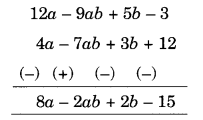
(b) Subtract 3xy + 5yz – 7zx from 5xy – 2yz – 2zx + 10xyz
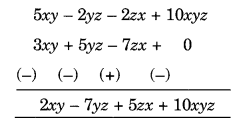
(c) Subtract 4p2q – 3pq + 5pq2 – 8p + 7q – 10 from 18 – 3p – 11q + 5pq – 2pq2 + 5p2q
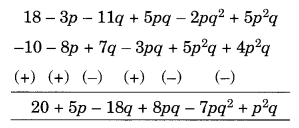
The terms are p2q – 7pq2 + 8pq – 18q + 5p + 20
Question 1.
Find the product of the following pairs of monomials.
(i) 4, 7p
(ii) -4p, 7p
(iii) -4p, 7pq
(iv) 4p3, -3p
(v) 4p, 0
Solution:
(i) 4 × 7p = (4 × 7) × p = 28p
(ii) -4p × 7p = (-4 × 7) × p × p = -28p2
(iii) -4p × 7pq = (-4 × 7) × p × pq = -28p2q
(iv) 4p3 × -3p = (4 × -3) × p3 × p = -12p4
(v) 4p x 0 = (4 × 0) × p = 0 × p = 0
Question 2.
Find the areas of rectangles with the following pairs of monomials as their lengths and breadths respectively.
(p, q); (10m, 5n); (20x2, 5y2); (4x, 3x2); (3mn, 4np)
Solution:
(i) Length = p units and breadth = q units
Area of the rectangle = length × breadth = p × q = pq sq units
(ii) Length = 10 m units, breadth = 5n units
Area of the rectangle = length × breadth = 10 m × 5 n = (10 × 5) × m × n = 50 mn sq units
(iii) Length = 20x2 units, breadth = 5y2 units
Area of the rectangle = length × breadth = 20x2 × 5y2 = (20 × 5) × x2 × y2 = 100x2y2 sq units
(iv) Length = 4x units, breadth = 3x2 units
Area of the rectangle = length × breadth = 4x × 3x2 = (4 × 3) × x × x2 = 12x3 sq units
(v) Length = 3mn units, breadth = 4np units
Area of the rectangle = length × breadth = 3mn × 4np = (3 × 4) × mn × np = 12mn2p sq units
Question 3.
Complete the table of Products.

Solution:
Completed Table
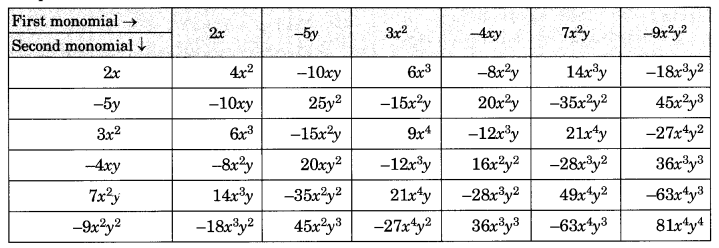
Question 4.
Obtain the volume of rectangular boxes with the following length, breadth and height respectively.
(i) 5a, 3a2, 7a4
(ii) 2p, 4q, 8r
(iii) xy, 2x2y, 2xy2
(iv) a, 2b, 3c
Solution:
(i) Here, length = 5a, breadth = 3a2, height = 7a4
Volume of the box = l × b × h = 5a × 3a2 × 7a4 = 105 a7 cu. units
(ii) Here, length = 2p, breadth = 4q, height = 8r
Volume of the box = l × b × h = 2p × 4q × 8r = 64pqr cu. units
(iii) Here, length = xy, breadth = 2x2y, height = 2xy2
Volume of the box = l × b × h = xy × 2x2y × 2xy2 = (1 × 2 × 2) × xy × x2y × xy2 = 4x4y4 cu. units
(iv) Here, length = a, breadth = 2b, height = 3c
Volume of the box = length × breadth × height = a × 2b × 3c = (1 × 2 × 3)abc = 6 abc cu. units
Question 5.
Obtain the product of
(i) xy, yz, zx
(ii) a, -a2, a3
(iii) 2, 4y, 8y2, 16y3
(iv) a, 2b, 3c, 6abc
(v) m, -mn, mnp
Solution:
(i) xy × yz × zx = x2y2z2
(ii) a × (-a2) × a3 = -a6
(iii) 2 × 4y × 8y2 × 16y3 = (2 × 4 × 8 × 16) × y × y2 × y3 = 1024y6
(iv) a × 2b × 3c × 6abc = (1 × 2 × 3 × 6) × a × b × c × abc = 36 a2b2c2
(v) m × (-mn) × mnp = [1 × (-1) × 1 ]m × mn × mnp = -m3n2p
Question 1.
Carry out the multiplication of the expressions in each of the following pairs:
(i) 4p, q + r
(ii) ab, a – b
(iii) a + b, 7a2b2
(iv) a2 – 9, 4a
(v) pq + qr + rp, 0
Solution:
(i) 4p × (q + r) = (4p × q) + (4p × r) = 4pq + 4pr
(ii) ab, a – b = ab × (a – b) = (ab × a) – (ab × b) = a2b – ab2
(iii) (a + b) × 7a2b2 = (a × 7a2b2) + (b × 7a2b2) = 7a3b2 + 7a2b3
(iv) (a2 – 9) × 4a = (a2 × 4a) – (9 × 4a) = 4a3 – 36a
(v) (pq + qr + rp) × 0 = 0
[∵ Any number multiplied by 0 is = 0]
Question 2.
Complete the table.
| S.No. | First Expression | Second Expression | Product |
| (i) | a | b + c + d | – |
| (ii) | x + y – 5 | 5xy | – |
| (iii) | p | 6p2 – 7p + 5 | – |
| (iv) | 4p2q2 | p2 – q2 | – |
| (v) | a + b + c | abc | – |
Solution:
(i) a × (b + c + d) = (a × b) + (a × c) + (a × d) = ab + ac + ad
(ii) (x + y – 5) (5xy) = (x × 5xy) + (y × 5xy) – (5 × 5xy) = 5x2y + 5xy2 – 25xy
(iii) p × (6p2 – 7p + 5) = (p × 6p2) – (p × 7p) + (p × 5) = 6p3 – 7p2 + 5p
(iv) 4p2q2 × (p2 – q2) = 4p2q2 × p2 – 4p2q2 × q2 = 4p4q2 – 4p2q4
(v) (a + b + c) × (abc) = (a × abc) + (b × abc) + (c × abc) = a2bc + ab2c + abc2
Completed Table:
| S.No. | First Expression | Second Expression | Product |
| (i) | a | b + c + d | ab + ac + ad |
| (ii) | x + y – 5 | 5xy | 5x2y + 5xy2 – 25xy |
| (iii) | p | 6p2 – 7p + 5 | 6p3 – 7p2 + 5p |
| (iv) | 4p2q2 | p2 – q2 | 4p4q2 – 4p2q4 |
| (v) | a + b + c | abc | a2bc + ab2c + abc2 |
Question 3.
Find the products.

Solution:
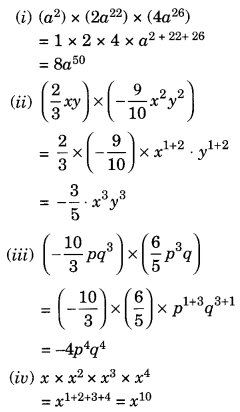
Question 4.
(a) Simplify: 3x(4x – 5) + 3 and find its values for (i) x = 3 (ii) x =![]()
(b) Simplify: a(a2 + a + 1) + 5 and find its value for (i) a = 0 (ii) a = 1 (iii) a = -1
Solution:
(a) We have 3x(4x – 5) + 3 = 4x × 3x – 5 × 3x + 3 = 12x2 – 15x + 3
(i) For x = 3, we have
12 × (3)2 – 15 × 3 + 3 = 12 × 9 – 45 + 3 = 108 – 42 = 66
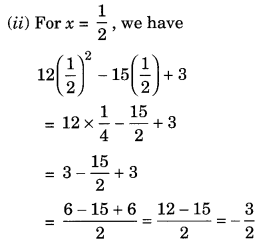
(b) We have a(a2 + a + 1) + 5
= (a2 × a) + (a × a) + (1 × a) + 5
= a3 + a2 + a + 5
(i) For a = 0, we have
= (0)3 + (0)2 + (0) + 5 = 5
(ii) For a = 1, we have
= (1)3 + (1)2 + (1) + 5 = 1 + 1 + 1 + 5 = 8
(iii) For a = -1, we have
= (-1)3 + (-1)2 + (-1) + 5 = -1 + 1 – 1 + 5 = 4
Question 5.
(a) Add: p(p – q), q(q – r) and r(r – p)
(b) Add: 2x(z – x – y) and 2y(z – y – x)
(c) Subtract: 3l(l – 4m + 5n) from 4l(10n – 3m + 2l)
(d) Subtract: 3a(a + b + c) – 2b(a – b + c) from 4c(-a + b + c)
Solution:
(a) p(p – q) + q(q – r) + r(r – p)
= (p × p) – (p × q) + (q × q) – (q × r) + (r × r) – (r × p)
= p2 – pq + q2 – qr + r2 – rp
= p2 + q2 + r2 – pq – qr – rp
(b) 2x(z – x – y) + 2y(z – y – x)
= (2x × z) – (2x × x) – (2x × y) + (2y × z) – (2y × y) – (2y × x)
= 2xz – 2x2 – 2xy + 2yz – 2y2 – 2xy
= -2x2 – 2y2 + 2xz + 2yz – 4xy
= -2x2 – 2y2 – 4xy + 2yz + 2xz
(c) 4l(10n – 3m + 2l) – 3l(l – 4m + 5n)
= (4l × 10n) – (4l × 3m) + (4l × 2l) – (3l × l) – (3l × -4m) – (3l × 5n)
= 40ln – 12lm + 8l2 – 3l2 + 12lm – 15ln
= (40ln – 15ln) + (-12lm + 12lm) + (8l2 – 3l2)
= 25ln + 0 + 5l2
= 25ln + 5l2
= 5l2 + 25ln
(d) [4c(-a + b + c)] – [3a(a + b + c) – 2b(a – b + c)]
= (-4ac + 4bc + 4c2) – (3a2 + 3ab + 3ac – 2ab + 2b2 – 2bc)
= -4ac + 4bc + 4c2 – 3a2 – 3ab – 3ac + 2ab – 2b2 + 2bc
= -3a2 – 2b2 + 4c2 – ab + 6bc – 7ac
Question 1.
Multiply the binomials:
(i) (2x + 5) and (4x – 3)
(ii) (y – 8) and (3y – 4)
(iii) (2.5l – 0.5m) and (2.5l + 0.5m)
(iv) (a + 3b) and (x + 5)
(v) (2pq + 3q2) and (3pq – 2q2)
(vi) (¾ a2 + 3b2) and 4(a2 –2/3 b2)
Solution:
(i) (2x + 5) × (4x – 3)
= 2x × (4x – 3) + 5 × (4x – 3)
= (2x × 4x) – (3 × 2x) + (5 × 4x) – (5 × 3)
= 8x2 – 6x + 20x – 15
= 8x2 + 14x – 15
(ii) (y – 8) × (3y – 4)
= y × (3y – 4) – 8 × (3y – 4)
= (y × 3y) – (y × 4) – (8 × 3y) + (-8 × -4)
= 3y2 – 4y – 24y + 32
= 3y2 – 28y + 32
(iii) (2.5l – 0.5m) × (2.5l + 0.5m)
= (2.5l × 2.5l) + (2.5l × 0.5m) – (0.5m × 2.5l) – (0.5m × 0.5m)
= 6.25l2 + 1.25ml – 1.25ml – 0.25m2
= 6.25l2 + 0 – 0.25m2
= 6.25l2 – 0.25m2
(iv) (a + 3b) × (x + 5)
= a × (x + 5) + 36 × (x + 5)
= (a × x) + (a × 5) + (36 × x) + (36 × 5)
= ax + 5a + 3bx + 15b
(v) (2pq + 3q2) × (3pq – 2q2)
= 2pq × (3pq – 2q2) + 3q2 (3pq – 2q2)
= (2pq × 3pq) – (2pq × 2q2) + (3q2 × 3pq) – (3q2 × 2q2)
= 6p2q2 – 4pq3 + 9pq3 – 6q4
= 6p2q2 + 5pq3 – 6q4
Question 2.
Find the product:
(i) (5 – 2x) (3 + x)
(ii) (x + 7y) (7x – y)
(iii) (a2 + b) (a + b2)
(iv) (p2 – q2)(2p + q)
Solution:
(i) (5 – 2x) (3 + x)
= 5(3 + x) – 2x(3 + x)
= (5 × 3) + (5 × x) – (2x × 3) – (2x × x)
= 15 + 5x – 6x – 2x2
(ii) (x + 7y) (7x – y)
= x(7x – y) + 7y(7x – y)
= (x × 7x) – (x × y) + (7y × 7x) – (7y × y)
= 7x2 – xy + 49xy – 7y2
= 7x2 + 48xy – 7y2
(iii) (a2 + b) (a + b2)
= a2 (a + b2) + b(a + b2)
= (a2 × a) + (a2 × b2) + (b × a) + (b × b2)
= a3 + a2b2 + ab + b3
(iv) (p2 – q2)(2p + q)
= p2(2p + q) – q2(2p + q)
= (p2 × 2p) + (p2 × q) – (q2 × 2p) – (q2 × q)
= 2p3 + p2q – 2pq2 – q3
Question 3.
Simplify:
(i) (x2 – 5) (x + 5) + 25
(ii) (a2 + 5)(b3 + 3) + 5
(iii) (t + s2) (t2 – s)
(iv) (a + b) (c – d) + (a – b) (c + d) + 2(ac + bd)
(v) (x + y) (2x + y) + (x + 2y) (x – y)
(vi) (x + y)(x2 – xy + y2)
(vii) (1.5x – 4y)(1.5x + 4y + 3) – 4.5x + 12y
(viii) (a + b + c) (a + b – c)
Solution:
(i) (x2 – 5) (x + 5) + 25
= x2(x + 5) + 5(x + 5) + 25
= x3 + 5x2 – 5x – 25 + 25
= x3 + 5x2 – 5x + 0
= x3 + 5x2 – 5x
(ii) (a2 + 5)(b3 + 3) + 5
= a2(b3 + 3) + 5(b3 + 3) + 5
= a2b3 + 3a2 + 5b3 + 15 + 5
= a2b3 + 3a2 + 5b3 + 20
(iii) (t + s2) (t2 – s)
= t(t2 – s) + s2(t2 – s)
= t3 – st + s2t2 – s3
= t3 + s2t2 – st – s3
(iv) (a + b)(c – d) + (a – b) (c + d) + 2(ac + bd)
= a(c – d) + b(c – d) + a(c + d) – b(c + d) + 2ac + 2bd
= ac – ad + bc – bd + ac + ad – bc – bd + 2ac + 2bd
= ac + ac + 2ac + bc – bc – ad + ad – bd – bd + 2bd
= 4ac + 0 + 0 + 0
= 4ac
(v) (x + y) (2x + y) + (x + 2y) (x – y)
= x(2x + y) + y(2x + y) + x(x – y) + 2y(x – y)
= 2x2 + xy + 2xy + y2 + x2 – xy + 2xy – 2y2
= 2x2 + x2 + xy + 2xy – xy + 2xy + y2 – 2y2
= 3x2 + 4xy – y2
(vi) (x + y)(x2 – xy + y2)
= x(x2 – xy + y2) + y(x2 – xy + y2)
= x3 – x2y + x2y + xy2 – xy2 + y3
= x3 – 0 + 0 + y3
= x3 + y3
(vii) (1.5x – 4y)(1.5x + 4y + 3) – 4.5x.+ 12y
= 1.5x (1.5x + 4y + 3) – 4y(1.5x + 4y + 3) – 4.5x + 12y
= 2.25x2 + 6xy + 4.5x – 6xy – 16y2 – 12y – 4.5x + 12y
= 2.25x2 + 6xy – 6xy + 4.5x – 4.5x + 12y – 12y – 16y2
= 2.25x2 + 0 + 0 + 0 – 16y2
= 2.25x2 – 16y2
(viii) (a + b + c) (a + b – c)
= a(a + b – c) + b(a + b – c) + c(a + b – c)
= a2 + ab – ac + ab + b2 – bc + ac + bc – c2
= a2 + ab + ab – bc + bc – ac + ac + b2 – c2
= a2 + 2ab + b2 – c2 + 0 + 0
= a2 + 2ab + b2 – c2
Question 1.
Use a suitable identity to get each of the following products:
(i) (x + 3) (x + 3)
(ii) (2y + 5) (2y + 5)
(iii) (2a – 7) (2a – 7)
(iv) (3a – ![]() ) (3a –
) (3a – ![]() )
)
(v) (1.1m – 0.4) (1.1m + 0.4)
(vi) (a2 + b2) (-a2 + b2)
(vii) (6x – 7) (6x + 7)
(viii) (-a + c) (-a + c)
(ix) ( +
) (
+
)
(x) (7a – 9b) (7a – 9b)
Solution:
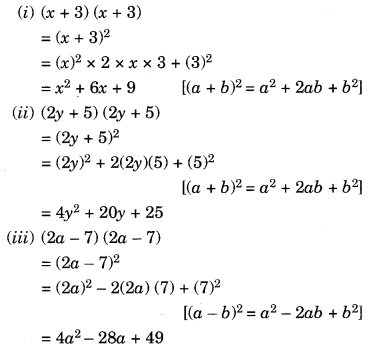
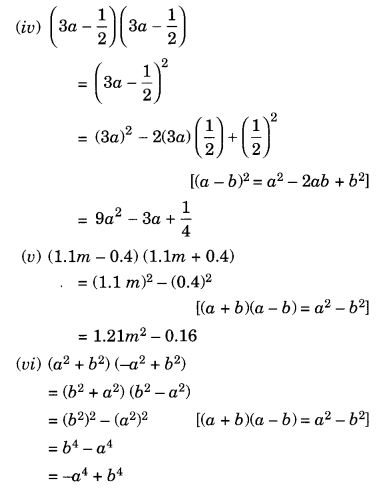


Question 2.
Use the identity (x + a)(x + b) = x2 + (a + b)x + ab to find the following products.
(i) (x + 3) (x + 7)
(ii) (4x + 5)(4x + 1)
(iii) (4x – 5) (4x – 1)
(iv) (4x + 5) (4x – 1)
(v) (2x + 5y) (2x + 3y)
(vi) (2a2 + 9) (2a2 + 5)
(vii) (xyz – 4) (xyz – 2)
Solution:

